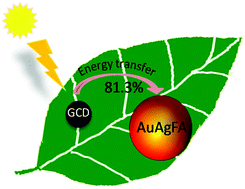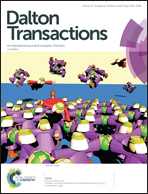Carbon dot–Au(i)Ag(0) assembly for the construction of an artificial light harvesting system†
Abstract
Artificial light harvesting systems (LHS) with inorganic counterparts are considered to be robust as well as mechanistically simple, where the system follows the donor–acceptor principle with an unchanged structural pattern. Plasmonic gold or silver nanoparticles are mostly chosen as inorganic counterparts to design artificial LHS. To capitalize on its electron accepting capability, Au(I) has been considered in this work for the synergistic stabilization of a system with intriguingly fluorescing silver(0) clusters produced in situ. Thus a stable fluorescent Au(I)Ag(0) assembly is generated with electron accepting capabilities. On the other hand, carbon dots have evolved as new fluorescent probes due to their unique physicochemical properties. Utilizing the simple electronic behavior of carbon dots, an electronic interaction between the fluorescent Au(I)Ag(0) and a carbon dot has been investigated for the construction of a new artificial light harvesting system. This coinage metal assembly allows surface energy transfer where it acts as an acceptor, while the carbon dot behaves as a good donor. The energy transfer efficiency has been calculated experimentally to be significant (81.3%) and the Au(I)Ag(0)–carbon dot assembly paves the way for efficient artificial LHS.



 Please wait while we load your content...
Please wait while we load your content...